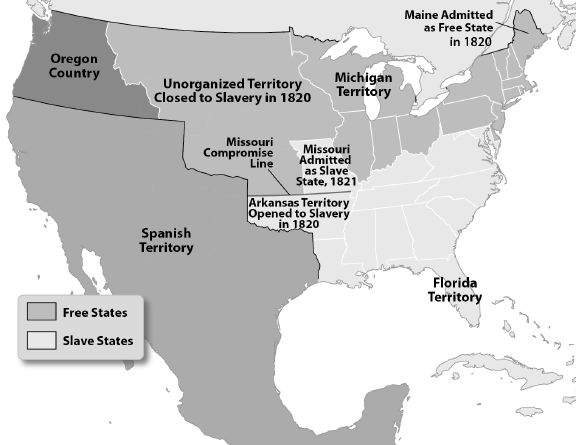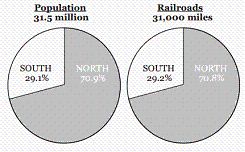Multiple Choice
Identify the
choice that best completes the statement or answers the question.
|
|
|
1.
|
Which explains why Abraham Lincoln’s name was
left off the Louisiana ballot in 1860?
a. | Louisiana did not recognize the Republican
Party. | b. | Lincoln’s stand on slavery made him an enemy of
Louisiana. | c. | The Republican
Party did not meet the deadline to get Lincoln’s name on the ballot. | d. | The printer left Lincoln’s name off intentionally because he did not
want Lincoln to win. |
|
|
|
2.
|
Which explains the goal of the Anaconda
Plan?
a. | to capture the capital of the
Confederacy | b. | to keep supplies
from entering New Orleans | c. | to capture
Jefferson Davis and force him to end the war | d. | to gain control of
the Mississippi and defeat the Confederacy |
|
|
|
3.
|
Where did the longest siege of the Civil War
occur?
a. | Baton Rouge | b. | New Orleans | c. | Port
Hudson | d. | Vicksburg |
|
|
|
4.
|
Which city was the destination of the final Union
campaign in Louisiana?
a. | Baton Rouge | b. | New Orleans | c. | Monroe | d. | Shreveport |
|
|
|
5.
|
What was the purpose of the Emancipation
Proclamation?
a. | to free the slaves | b. | to get the slaves to join the Union army | c. | to secure Lincoln’s popularity with the North | d. | to pressure the Confederates to end the
war |
|
|
|
Use the map to answer the question(s). 
|
|
|
6.
|
Which part of the state was occupied the
longest?
a. | Northeast | b. | Southeast | c. | Northwest | d. | Southwest |
|
|
|
7.
|
How were Confederates in the Florida Parishes
affected by Union occupation?
a. | They sought refuge in New
Orleans. | b. | They were isolated from the rest of the
state. | c. | They were able to maintain control of the Red
River. | d. | They continued to receive supplies through New
Orleans. |
|
|
|
8.
|
Which conclusion can be drawn about the role of the
Mississippi in the Union strategy?
a. | The Mississippi was not as important as the Red
River. | b. | Controlling the Mississippi was not part of the
Union’s strategy. | c. | Much of the
Union’s strategy depended on controlling the Mississippi. | d. | Annual flooding made it too difficult for the Union to use the river to their
advantage. |
|
|
|
9.
|
Which city on the Red River was occupied by the
Union army?
a. | Alexandria | c. | Natchitoches | b. | Bossier | d. | Shreveport |
|
|
|
10.
|
Which of the following is the definition for
emancipate?
a. | sell | b. | capture | c. | enslave | d. | set
free |
|
|
|
Use the information in the timeline to answer the next question(s). 
|
|
|
11.
|
Which event occurred in 1861?
a. | Louisiana seceded from U.S. | b. | Abraham Lincoln elected president | c. | Emancipation Proclamation freed slaves | d. | Louisiana legislature met to discuss
secession |
|
|
|
12.
|
Which event occurred in 1863?
a. | Battle of New Orleans | b. | Louisiana State adopts tiger mascot | c. | General Beauregard fired on Fort Sumter | d. | Confederates surrendered at Port Hudson |
|
|
|
13.
|
The events of 1862 were a part of which Union
strategy?
a. | blockade | b. | total warfare | c. | emancipation | d. | trench
warfare |
|
|
|
14.
|
Which explains why southern states supported the
institution of slavery?
a. | It was part of their religious
beliefs. | b. | Farmers could not grow crops without
slaves. | c. | Their economic system was dependent on slave
labor. | d. | The industrialized southern states depended on slaves to
work in factories. |
|
|
|
|
|
|
15.
|
Who do the primary characters represent in this
cartoon?
a. | Republicans and abolitionists | b. | Jefferson Davis and Betsy Ross | c. | Northern States and Southern States | d. | Federal Government and State
Governments |
|
|
|
16.
|
Which of the following is the author’s
intended message?
a. | Disobedient slaves were the cause of the Civil
War. | b. | The argument over slavery was tearing the United States
apart. | c. | Southern families needed to stick together or their
slaves would revolt. | d. | Jefferson
Davis’ family fought over whether or not they should own
slaves. |
|
|
|
17.
|
Which was the purpose of the Missouri Compromise
and the Compromise of 1850?
a. | settle tax disputes | b. | settle trade disputes | c. | settle disputes
over land claims | d. | settle disputes
over slavery |
|
|
|
18.
|
United States - 1821
 What was the purpose of the Missouri Compromise
line? What was the purpose of the Missouri Compromise
line?
a. | to evenly divide the remaining Louisiana Purchase
lands | b. | to mark the northern boundary of the Arkansas
territory | c. | to mark the division between Union and Confederate
states | d. | to provide a line of demarcation between slave and
fee states |
|
|
|
19.
|
What is popular sovereignty?
a. | The ability of the people of an area to decide an issue
for themselves. | b. | The idea that a
presidential election should be decided by popular vote. | c. | The right of people to assemble and protest the United States
government. | d. | The belief that
state governments should have more power than the federal
government. |
|
|
|
|
|
|
20.
|
This poster would have been created following which
event?
a. | Wilmot Proviso | b. | Fugitive Slave Law | c. | Missouri
Compromise | d. | Confederate States
of America formed |
|
|
|
21.
|
Which group would have posted this
message?
a. | abolitionists | b. | slave owners | c. | slave
catchers | d. | police officers |
|
|
|
22.
|
Which best explains the Fugitive Slave
Act?
a. | It allowed for continued international slave
trading. | b. | It fined judges who rejected a slave owner’s
claim. | c. | It allowed runaway slaves to remain free if they reached
a free state. | d. | It required all
citizens to assist officials in the locating and return of escaped
slaves. |
|
|
|
23.
|
Which is an example of
sectionalism?
a. | leading a slave revolt | b. | creating a new political party | c. | dividing the nation based on slave or free | d. | dividing Congress into the Senate and House of
Representatives |
|
|
|
24.
|
Which was the Republican Party’s stance on
slavery during the 1860 election?
a. | All slavery must be
abolished. | b. | Slavery could
continue in current slave states. | c. | Slavery should be
abolished in all states but not territories. | d. | Slavery would be
allowed to continue in current and future states. |
|
|
|
25.
|
Who won the electoral vote in the presidential
election of 1860?
a. | Abraham Lincoln | c. | John
Breckinridge | b. | John
Bell | d. | Stephen Douglas |
|
|
|
26.
|
What was Louisiana’s primary concern when
considering secession?
a. | safety | b. | political impact | c. | economic
impact | d. | charges of
treason |
|
|
|
27.
|
United States, 1860  Which conclusion can be drawn from the graphs? Which conclusion can be drawn from the graphs?a. | The Confederacy was more prepared to fight a
war. | b. | The Union underestimated the Confederacy’s
military strength. | c. | The Union would
have a greater advantage during the Civil War. | d. | The Union and
Confederacy were evenly matched at the beginning of the Civil
War. |
|
|
|
28.
|
Which of the following was a result of the attack
on Fort Sumter?
a. | The Confederate States of America was
formed. | b. | Lincoln issued the Emancipation
Proclamation. | c. | The Union and
Confederacy went to war. | d. | The Fugitive Slave
Act was revoked. |
|
|
|
29.
|
How did the Confederate government try to increase
voluntary military service?
a. | They offered a bounty. | b. | They offered free land. | c. | They offered more
leadership positions. | d. | They offered
shortened terms of enlistment. |
|
|
|
30.
|
How was the complaint “a rich man’s
struggle but a poor man’s fight” related to the Conscription Act?
a. | The draft had a salary cap. | b. | Immigrants were drafted before native citizens. | c. | The draft only applied to freedmen who were against
slavery. | d. | Draft exemptions favored upper class professionals and
those who benefited from slavery. |
|